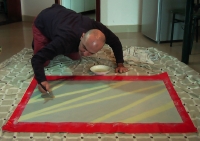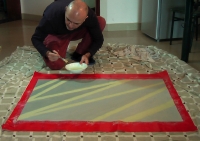Marco Maurizio Gobbo
Nasce a Milano, il 14 luglio 1961.
Rivela una spiccata vocazione artistica sin da molto giovane, imparando disegno e pittura da autodidatta.
Nel corso dell'adolescenza sviluppa interessi verso la scrittura e la recitazione, lavorando per diverse compagnie teatrali amatoriali e semi professioniste, rivestendo i panni di attore, scrittore e regista.
Nel 1990 si trasferisce a Londra, rientra in Italia nel 1994.
Rientrato in Italia si associa a "Il Raccolto, Sodalizio di Artisti e Autori di tutte le discipline per la Cultura" diretto da Daniele Oppi.
Nel 1998 diventa allievo della Maestra Mintoy, pittrice e ricercatrice cromoplastica. Mintoy e' Maestro che azzera il discorso pittorico per concentrarsi solo sul colore, inteso come "luce pura", lirica portatrice di concetti, significati e sentimenti.
Marco Maurizio Gobbo seguendo l'insegnamento di Mintoy sviluppa poi un proprio discorso pittorico dove il colore puro e' usato in forma astratta e rappresentativa, via via esplorando tecniche vicine alle correnti del Neo Espressionismo, dell'Action Painting e della Lyrical Abstraction.
Dal 2006 vive in Cina.
Pittore, scrittore, drammaturgo. Attore, indomito ricostruttore di scenari esistenziali e attento studioso delle cose del mondo, ha affrontato e affronta la vita come un eterno esperimento, infondendo passione e autentico ottimismo nelle opere che fa e in coloro che hanno la fortuna di incapparvi.
Credo che sia questo singolare eclettismo di fondo (che si esprime nel fare artistico come nella quotidianita') che impedisca, o perlomeno, provochi una certa fatica, non solo a chi, come me, deve qui provare a parlare di Marco Maurizio Gobbo chiudendolo nei confini a lui troppo stretti della pittura, ma anche a chi e' chiamato a guardare le sue opere pittoriche come esclusivamente tali.
Marco Maurizio Gobbo non e' un pittore, se con questo intendiamo qualcuno che strugge di colori e di simboli la sua tela, ma un artista gia' definitivamente consegnato a quel post-moderno che ha superato e supera qualsiasi definizione classificatoria, per includere nel fare creativo la vita stessa, la propria bio-grafia costruita e ricostruita come opera che, quindi, include qualsiasi gesto (compreso quello pittorico) senza sublimarlo.
Anzi, e' proprio dell'opera di Marco Maurizio Gobbo quel processo di sdefinizione della sfera estetica, quella perdita di esemplarita' dell'arte che, nella sua pittura, sembra fissarsi astilisticamente in un continuo gioco citazionista di stilemi e di modelli che sembrano attraversare la storia dell'arte senza fissarsi in alcuno.
In questo senso l'opera pittorica di Marco Maurizio Gobbo appartiene al post -moderno, ossia a quel processo che, come scrive Umberto Eco nel suo "Postille al Nome della Rosa", "Consiste nel riconoscere che il passato, visto che non puo' essere distrutto, perche' la sua distruzione porta al silenzio, deve essere rivalutato con ironia, in modo non innocente".
Ecco, le opere pittoriche di Marco Maurizio Gobbo (che - ripeto - a mio avviso dovrebbero essere accompagnate da uno sguardo attento alla sua biografia) sono le opere di questa innocenza perduta che segna la post-modernita'; il segno di un uomo (l'Uomo Contemporaneo) che, per stare ancora con Eco, non puo' piu' dire "Ti amo disperatamente", ma puo' dire "Come direbbe Liala, ti amo disperatamente".
Allo stesso modo le opere pittoriche di Marco Maurizio Gobbo sono i quadri di un quadro dipinto da qualcun altro, ri-dipinti e ri-messi in gioco in un'operazione riflessiva che ci obbliga, in qualche modo, ad una concettualizzazione, ad una intellettualizzazione del fatto artistico, premessa indispensabile alla comprensione dell'oggetto d'arte.
E allora, per vedere davvero le opere di Marco Maurizio Gobbo, e' necessario compiere lo sforzo (che sottolineavamo all'inizio di questo articolo) di andare oltre la pura rappresentazione della tela. E' necessario, piu' che vedere, guardare, cogliere i nessi e le fratture, ricontestualizzarle continuamente alla luce della opere cui rimandano; palparne le fessure inconsiderate; provare a distinguere, in ogni segno,
il segnale di un mondo in continua trasformazione che si aggrappa al "gia' stato" per paura di smarrirsi. Ma. sopratutto, per comprenderne fino in fondo il peso, e' fondamentale il parallelo che si apre con l'Opera che racchiude le opere pittoriche di Marco Maurizio Gobbo: la sua vita che,invece, incessantemente, combatte e si sforza di allontanarsi dal "gia' stato".
In questa dicotomia e' racchiusa la formula traduttrice e in parte traditrice (in quanto la biografia ha sempre difficolta' a emergere dall'opera) della pittura di Marco Maurizio Gobbo.
Marco Maurizio Gobbo e' tra i fondatori e animatori di The Making - Art Management di Hong Kong, ricoprendo il ruolo di Asia Managing Director. Attualmente lavora tra Asia e Europa.
Puoi seguirlo leggendo i suoi blogs:
themaking.blog.exibart.com in Italiano
themaking.blog.com in Inglese
Mostre :
- "Generazioni", mostra in binomio con il pittore Walter Negri, maggio 2006 presso Skip Intro - Milano (Italia)
- Mostra Collettiva presso il Comune di Brunate (Como), giugno 2001
 Working for Chromatology
Working for Chromatology
LINK : The Making
The Making ArtAsia - Blog Italiano
ArtAsia - Blog Italiano IL RACCOLTO
IL RACCOLTO Daniele Oppi
Daniele Oppi
 Working for Chromatology
Working for Chromatology
LINK : The Making
The Making ArtAsia - English Blog
ArtAsia - English Blog IL RACCOLTO
IL RACCOLTO Daniele Oppi
Daniele Oppi
Marco Maurizio Gobbo
Born in Milan on 14 July 1961.
Reveals a pronounced artistic vocation from an early age, learning and teaching himself drawing and painting.
During his adolescence developed an interest in writing and acting, working for various amateur and semi-professional theater companies, covering the roles of actor, writer and director.
In 1990 he moved to London, returned to Italy in 1994.
Back in Italy he joined "Il Raccolto, Association of Authors and Artists of all Cultural's disciplines" directed by Daniele Oppi.
In 1998 Marco Maurizio Gobbo becomes a student and apprentice of the Master painter Mintoy. Starting from the unique use of colors and hues in the works of James Ensor, and Olga Rozanova, Mintoy is a "visual searcher" who use colors and chromatic nuances, intended as pure light, as expression of concepts, meanings and emotions.
Marco Maurizio Gobbo develops its own painting discourse where pure colors are used in Abstract and Representative form, gradually exploring techniques close to Neo Expressionism, Action Painting and Lyrical Abstraction.
Since 2006 lives in China.
Painter, writer, playwriter. Actor, indomitable reenactor of life scenarios and keen scholar of the things of the world, he has faced and faces life as an eternal experiment, infusing passion and genuine optimism in the work he does and in those who are fortunate enough to have stumbled in it.
I think that it is this fundamentally unique eclecticism (which is expressed in his art making as in his everyday life) that prevents, or at least cause some difficulty, not only to those who, like me, must try to speak here of Marco Maurizio Gobbo enclosing him by the too tight boundaries of painting, but also to whom is called to look at his paintings solely as such.
Marco Maurizio Gobbo is not a painter, if by that we mean someone who yearns colors and symbols of his canvas, but an artist already and finally delivered to that post-modern that has passed and goes beyond any definition of classification, to include in his creative life, life itself, its bio-graphy built and rebuilt as a Work that, therefore, includes any act (including painting) without sublimate it.
Indeed, it is proper of the works of Marco Maurizio Gobbo that process of un-defined or s-defined of the aesthetic sphere, that loss of exemplary in art which, in his painting, seems to set a-stylistically in a constant game of quotations and stylistic features of models that seem to go through history of art without setting in any of them.
In this sense, the paintings of Marco Maurizio Gobbo belongs to the post-modern, ie the process that, as Umberto Eco writes in his "Postille al Nome della Rosa", "is to recognize that the past, since it can not be destroyed, because its destruction would lead us to silence, must be reassessed with irony, in a not 'so innocent way."
Here, the paintings of Marco Maurizio Gobbo (which - I repeat - in my opinion should be accompanied by a careful look at his biography) are works of that "lost innocence" time that marks the post-modern, the sign of a man (the Contemporary Man) which, to be with Eco, can not say anymore :"I love you desperately", but can say "Like Liala would say, I love you desperately."
Similarly, the paintings of Marco Maurizio Gobbo are paintings of a painting painted by someone else, re-painted and re-turned upon in a reflective operation that forces us, in some way, in an intellectualization of the artistic fact, indispensable requirement to the understanding of the art-object.
So, to actually see the works of Marco Maurizio Gobbo, we must make the effort (which we emphasized at the beginning of this article) to go beyond the mere representation of the canvas. It is necessary, more than to see them, to watch them, to understand their links and fractures, continually reconfigure them under the light of the works which they refer to, to palpate the still inconsiderate cracks, to try to distinguish, in every sign,
the signal of a changing world that clings to the 'has been' for fear of getting lost in it. But above all, to fully understand the value, it is paramount to draw a parallel with the opera that includes the paintings of Marco Maurizio Gobbo: his life that, on the contrary, incessantly, fights and tries to get away from what "has been".
In this dichotomy is contained the formula that translate and partially betray (because a Biography has always difficulties to emerge from the Opera) Marco Maurizio Gobbo's paintings.
Marco Maurizio Gobbo is among the founders and promoters of The Making - Art Management of Hong Kong, serving as Asia Managing Director. Currently works between Asia and Europe.
You may follow him reading his blogs:
themaking.blog.exibart.com in Italian
themaking.blog.com in English
Exibitions :
- "Generazioni" exhibition with painter Walter Negri, may 2006 at Skip Intro - Milan (Italy)
- Collective Exhibition, Comune di Brunate (Como) june 2001

 Massimo Silvano Galli
Massimo Silvano Galli Hiroshi Sakate
Hiroshi Sakate Massimo Silvano Galli
Massimo Silvano Galli Hiroshi Sakate
Hiroshi Sakate Previous
Previous